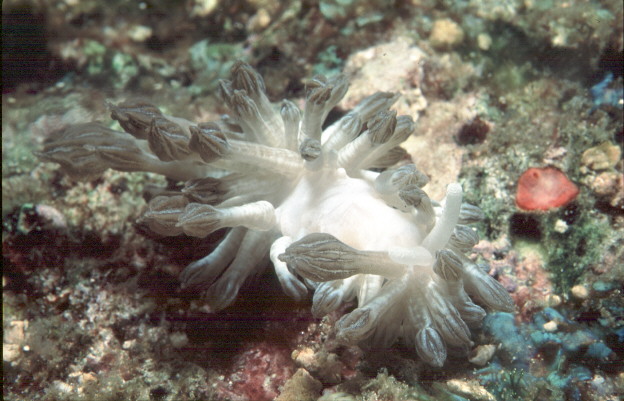
| Phyllodesmium sp. Batangas, Philippines 1995 |
Phyllodesmium sp.
This is one of the most fantastic examples of mimicry I have ever seen. Absolutely out of this world. Mike's photo shown here from Batangas region of Luzon, Philippine Islands, was one of the first observations of this undescribed aeolid nudibranch, belonging to the genus Phyllodesmium. Since then, we have received several other photos of this wonderful creature from the Indonesia area, and recently it was featured as "The Mystery Nudibranch" on Phil Slosberg's site.
The reason this species has gone so long without discovery is quite obvious due to its unbelievable masquerade as a colony of the soft coral,Xenia, see Gosliner, Behrens and Williams, Coral Reef Animals of the Indo-Pacific, pages 47-49, for examples of this coral species). As you can see here (from this link), and shown in detail on Slosberg's site, the cerata of this species are shaped identical to that of a closed polyp of the xenidid soft coral. Admirers of Xenia enjoy watching the coral polyps rhythmically open and close, across the face of a colony, feeding on microscopic plankton. The color of the nudibranch even matches that of the coral, the cerata of the nudibranch and pinnules of the coral polyps both containing zoozanthellae.
Phyllodesmium nudibranchs are known for their close association with their soft coral prey species and in several instances their very close similarity and resemblance to the physical features of their prey, making themselves quite cryptic and nearly invisible. Over the years, Mike has featured numerous species of nudibranchs displaying aposomatic, or bright warning colors. Unlike like the flamboyant chromodorids and Phyllidia's this species exhibits the extreme opposite in protective mechanisms, absolute concealment through perfect resemblance to its host.
Currently being prepared for description by Terry Gosliner, the species seems to range from the Lembah Straits of Indonesia to the Philippines, occurring at shallow depths. Its is always found on the delicate soft coral, Xenia.
Just as a hint - if you want to include a photo of the species in your portfolio, without spending the rest of your life tediously searching through acres of Xenia polyps - it does lay a rather large, brilliant white, undulating coil of eggs which tends to give its whereabouts away. Use this as a clue when hunting this most fascinating and alluring critter.
Taxonomic information courtesy of:

David W. Behrens
Author:
Pacific Coast Nudibranchs
Send Dave mail at seachalleng@earthlink.net
|
© The Slug Site, Michael D. Miller 1998 All Rights Reserved.
